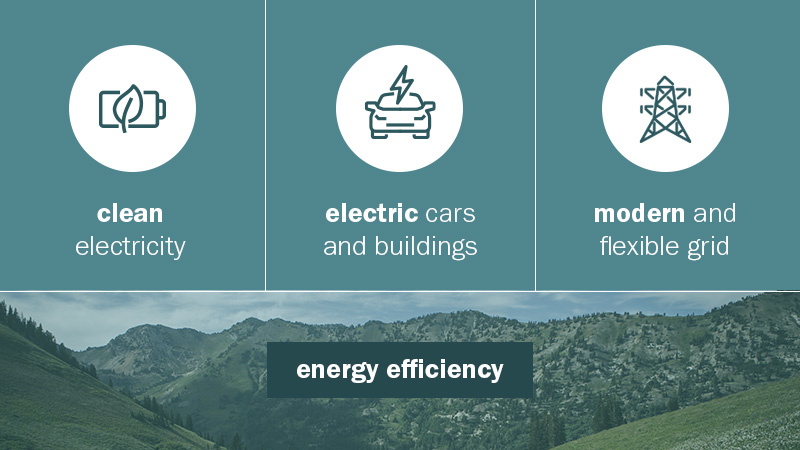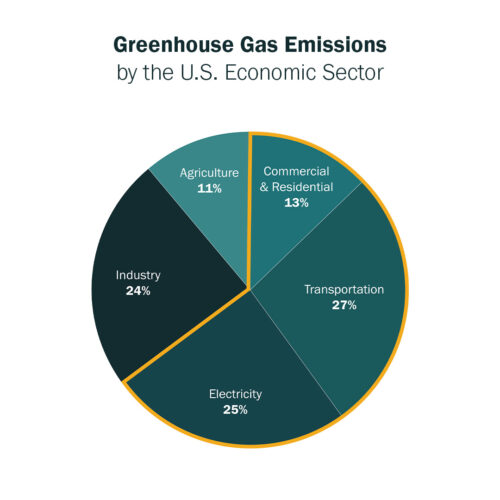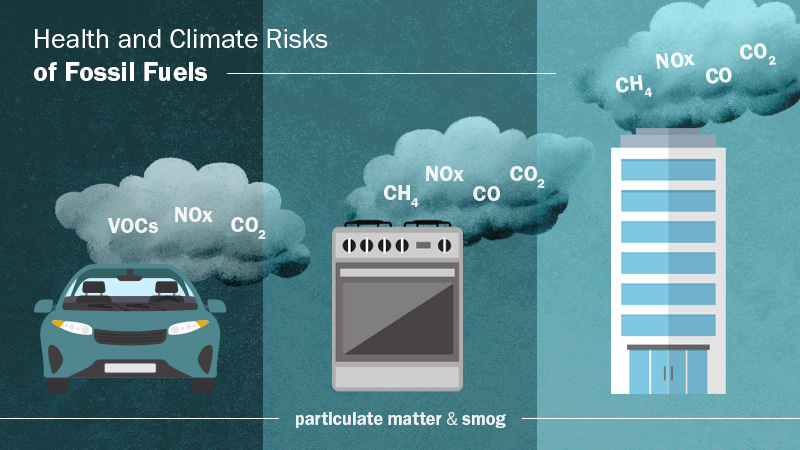June 22, 2022
Fighting climate change is hard. It is a global problem embedded in our economy, technology, and politics. WRA does its part to address climate change in the Interior West by developing and supporting policies that help our region reduce planet-heating greenhouse gas emissions. The more we do now to reduce greenhouse emissions, the fewer climate impacts we will experience. Mitigating climate change also brings substantial health benefits. As we reduce greenhouse emissions, we decrease other pollutants like ozone and particulate matter that degrade our air quality while harming our health.
How to address climate change in high-impact steps

- Be more energy efficient! Increasing efficiency reduces cost and technology barriers to cleaning up our energy systems.
- Clean up electricity generation. The electric power sector used to be the biggest source of greenhouse gas emissions, but its pollution levels are decreasing as we add renewable resources and other clean technologies to the grid.
- Use clean electricity to replace fossil fuels for transportation and buildings. We can compound the benefits of clean electricity by using it to power our cars and buildings.
- Modernize the electric grid. With new uses for clean electricity, we need to make sure the whole grid is efficient and capable of handling the increased demand.
All these steps should be pursued concurrently for maximum emissions reductions. WRA’s work on regional energy markets, distribution system planning, and creating a more flexible grid make important progress toward these aims.
The Current State of Climate Mitigation in the Interior West
Globally, average temperatures on the planet have already warmed by over 1 degree Celsius. Utah, where I live, has been heating up at twice the global average for the past 50 years, and we experience extreme consequences: wildfires and pervasive smoke; the worst drought in 1,200 years; and toxic dust blowing off the drying bed of the Great Salt Lake. These climate impacts exacerbate the already bad ozone pollution and particulate matter that get stuck in the airshed over the Wasatch Front.
According to the latest Intergovernmental Panel on Climate Change (IPCC) report, policies in place around the world have been successful in reducing the pace of global warming, but even with the progress we’ve made, we’re still on track to see the global average temperature rise over 3 degrees Celsius by 2100. In Utah, this means dwindling snowpack — the source of most of our water — and more frequent and extreme events such as heatwaves and wildfires. These effects of a changing climate disproportionately impact those who are most vulnerable and least equipped to adapt.
At WRA, we work on policies that aim to limit warming to a maximum of 2 degrees Celsius, to avoid the most catastrophic impacts to lives and livelihoods across the West. To limit warming, climate scientists say we must achieve net-zero carbon emissions by mid-century, with rapid, deep, and in most cases immediate greenhouse emissions reductions in all economic sectors, including electricity, transportation, buildings, and land use.
Some sectors are much easier (and less expensive) to decarbonize than others. For example, we already have cost-effective technologies like wind and solar generation and battery storage to reduce greenhouse gas emissions from electricity generation, but we do not yet have cost-effective technologies to reduce greenhouse emissions from producing common building materials like steel and cement, or from aviation and long-haul ocean transport.
But we need to move quickly to deploy the emission reduction tools that are available today. This is one of the reasons we at WRA focus so much on decarbonizing electricity generation — fast! A zero-carbon grid is necessary for reducing planet-heating fossil fuel emissions from other sectors, especially transportation and buildings.
Decarbonizing the power sector is a cost effective and important climate solution
A clean grid is the backbone of a zero-carbon economy. Clean electricity can support and uphold decarbonization in other sectors. Because we have made progress in cleaning up electricity, electricity generation now accounts for only 25% of emissions nationally, down from 33% in 2005 and 30% in 2014.
Decarbonizing electricity can also help reduce greenhouse gas emissions from other sectors, because we can transition from fossil-fueled cars and buildings to those that use clean electricity. This switch is sometimes called beneficial electrification. Powering the electric grid as well as cars and buildings with clean resources improves both outdoor and indoor air quality, protects public health, and reduces greenhouse gas emissions.

The next decade is critical in the race to get to net-zero greenhouse gas emissions by 2050, and we already have the technology to clean up electricity, switch to electric vehicles and buildings, and begin making crucial progress to limit global heating.
Switching cars and building to run on clean electricity brings major immediate climate and health benefits
As we clean up the grid, we can multiply emissions reductions by switching cars and buildings to run on clean electricity rather than fossil fuels. We also save a lot of energy, because electricity is a very efficient form of energy. In contrast, when you burn fossil fuels to generate energy, much of that energy is lost as heat.
When vehicles are powered by clean electricity, they can help us make substantial progress in curbing carbon pollution to address climate change. Transportation electrification involves transitioning personal cars, commercial fleets, and public transit from fossil-fueled vehicles to ones powered by electricity. This shift will fundamentally reshape our transportation and power systems by reducing demand for gasoline and increasing the demand for electricity. The transition to electric vehicles provides substantial economic, environmental, and public health benefits, and the faster the transition occurs, the faster those benefits are realized by our communities.
Currently in the Interior West, electric vehicles emit two to five times less greenhouse gas pollution than gasoline powered vehicles, depending on the source of the electricity. As we transition to ever cleaner electricity resources across the region, the benefits of transportation electrification increase.
Transitioning buildings to be all electric can also significantly decrease the emissions that drive climate change. Most buildings in the United States currently rely on various sources of fuel. While electricity powers lights, appliances, electronics, and often air conditioning, fossil methane (also called natural gas) or propane fuel our furnaces, boilers, water heaters, and sometimes our stoves. Building electrification involves a shift to buildings powered by wind, solar, and other sources of clean electricity.
In the Interior West, methane gas and other fossil fuels are used to heat about 77% of all homes — the highest proportion in the nation. In fact, homes and other buildings account for about 13% of all greenhouse gas emissions in the United States. Not only do building furnaces and appliances emit carbon pollution into the atmosphere, they create harmful indoor air pollution as well as outdoor air pollution and cost consumers more money over time.
In Utah, homes and buildings contribute 40% to our wintertime air pollution. Fortunately, we have more efficient, healthier options, and we can make a big difference simply by transitioning our homes and office buildings to electric power instead of gas. For example, replacing gas stoves with electric or induction stoves, substituting electric water heaters for gas ones, and installing heat pumps to replace gas furnaces would dramatically decrease emissions from existing buildings.
Salt Lake City is leading with policies to support renewable energy and power cars and buildings with clean electricity
In Utah, Salt Lake City has taken policy actions to address climate change, establishing itself as a national leader. Over the past several years, the city has worked with PacifiCorp (Utah’s largest electric utility) as well as the state Legislature to establish a path to serve Salt Lake residents, as well as those in a dozen other cities and municipalities, with 100% renewable energy on an annual basis by 2030.
Salt Lake City also has committed to expanding electric transportation options, including purchasing increasing numbers of electric fleet vehicles, with an aim of ensuring all new fleet vehicle purchases are electric by 2027. The city has worked to increase the number of EV chargers throughout the city and has passed or proposed resolutions to increase charging stations at multi-family properties.
On the building electrification front, the city has partnered with the Building Electrification Institute and Utah Clean Energy to support updated building codes and develop a report about the cost savings associated with all-electric buildings.
We need to reduce fossil fuel pollution from electricity, cars, and buildings to protect our health and the climate
We need to use this kind of multi-pronged approach across our region to reduce emissions from fossil fuels. Energy efficiency is the first step. We can ease the transition to clean energy by making the electric grid and our homes, buildings, and appliances as efficient as possible. This means cutting waste and being smart with the way we consume energy. As we rapidly decarbonize electricity production and convert cars and buildings to run on clean electricity, we will avoid fossil fuel emissions, mitigate the worst impacts of climate change, and improve our health.



